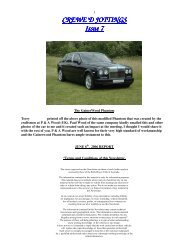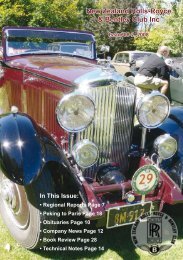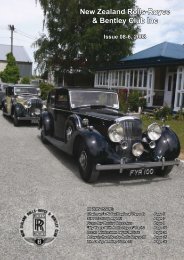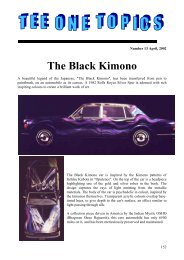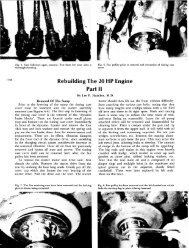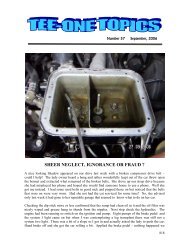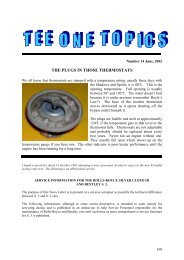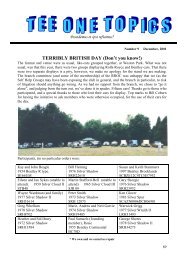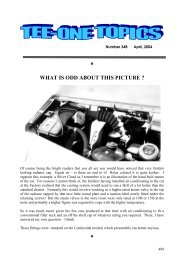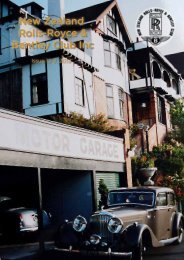New Zealand Rolls-Royce & Bentley Club Inc - KDA132
New Zealand Rolls-Royce & Bentley Club Inc - KDA132
New Zealand Rolls-Royce & Bentley Club Inc - KDA132
Create successful ePaper yourself
Turn your PDF publications into a flip-book with our unique Google optimized e-Paper software.
The Daimler was superseded by a 30-40 HP Darracq in 1905,<br />
and a 10-12 HP Darracq in 1907 – which between them covered<br />
86,820 miles during the five years they were running. Upon the<br />
sale of these, “1671”, the 1911 <strong>Rolls</strong>-<strong>Royce</strong>, enters the story.<br />
Ernie Waite<br />
Ernie remained at Gwavas from 1905 until 1917, when he took<br />
up farming on some of the adjacent land. In 1907 whilst at Gwavas<br />
he married Fanny Alessia McCutcheon the resident seam-stress/<br />
governess to the Carlyon children.<br />
In those days motoring was for the brave and adventurous.<br />
Ernie had his share of adventures, one of which was when he was<br />
charged with ‘furious driving” in 1906.<br />
“I had been travelling down Carlyle Street in Napier at about<br />
10 miles an hour when I passed a milk cart parked on the side<br />
of the road” he once recalled. “The horse shied, frightening two<br />
women, who immediately rushed to tell the driver of the cart what<br />
had happened. The driver ran out, jumped into the cart and chased<br />
me, catching me up near Clive Square, where he took my licence<br />
number. I was fined £8.”<br />
“With witness fees – (one man was brought from Palmerston<br />
North to testify) – the case cost me about £20. Not that it worried<br />
me, for my employer paid the money.”<br />
This incident, however, had an amusing sequel. A few days later<br />
there was a letter in the paper from a racing enthusiast enquiring if<br />
he could locate the horse concerned as he wished to buy it. “This<br />
Ernie Waite in “1671” in 1912 in front of Gwavas Homestead; at this time<br />
the car had covered 600 miles.<br />
“1671” as she was in the mid-‘70s.<br />
chap reckoned the horse must have galloped at about 50 miles an<br />
hour to have caught me up by Clive Square. He said it would be a<br />
dead cert for the next Derby”.<br />
Another incident whilst Ernie was at Gwavas; he was motoring<br />
up a hill when he saw a horse and trap at the top with two women<br />
in it. The women saw him too, and got down off the trap, unharnessed<br />
the horse, and held its head whilst he passed. “The horse<br />
wasn’t the slightest bit frightened, and just stood there eating the<br />
grass at the side of the road. Women were more scared of cars in<br />
those days than most horses!”<br />
Although motoring in Hawkes Bay in the early 1900s obviously<br />
had its lighter moments, there was a lot of hard work involved<br />
for the average motorist, for he had to be his own mechanic as<br />
well. This was no problem for Ernie who at Gwavas had his own<br />
workshop, lathe and battery charging plant, and used to make all<br />
his own spare parts.<br />
Ernie was 88 when the above-mentioned anecdotes were placed<br />
E.T.R. Carlyon driving “1671”, with his father A.S.G. in the passenger’s<br />
seat, and his wife Kathleen in the back.<br />
on record, and he was still driving regularly. By then he was a<br />
widower living in Napier, and passed away peacefully not long<br />
after – leaving behind, amongst other things, his 1953 fluidflywheel<br />
model Daimler – left to his mechanic “who was the only<br />
person who would know how to look after it properly” !!!<br />
“1671”<br />
1671 was a 40/50 h.p. Silver Ghost, test dated 21 st June 1911,<br />
and was delivered to <strong>New</strong> <strong>Zealand</strong> with formal coachwork. The<br />
original owner was ASG Carlyon, and in the 1912 <strong>New</strong> <strong>Zealand</strong><br />
Motor and Cycle Journal “1671” was described as “one of the finest<br />
cars in the Dominion” and “one of the most striking models running<br />
in the Hawke’s Bay province, where so many cars are in use.”<br />
The narrative at the time also said:<br />
“It will be noticed on glancing at the illustration that the back<br />
screen is folded in half; this screen, when in position, and with<br />
the hood up, fits close up to the latter. The two boxes on the step<br />
contain batteries, the one with the strap being the ignition battery<br />
and the other the lighting battery.<br />
“The white body of the car is lined in red, while the upholstery<br />
is in red leather. The length overall of the car is 16ft 6in and the<br />
width 5ft 9in, while the wheelbase is 12ft. The car is fitted with<br />
Rudge Whitworth (895mm by 135mm) wheels with Dunlop nonskid<br />
tyres, with leather cover and steel studs. It contains two petrol<br />
tanks, one behind and the other under the front seat, with a capacity<br />
to hold 20 gallons of petrol. Electric side, hind and dash lamps are<br />
fitted, dissolved acetylene being used for the headlights.<br />
“The car has been driven 600 miles, and has given complete<br />
satisfaction. An idea is gained of its smooth running by the fact<br />
“1671” as she is today, in the hands of Mike and Cynthia Sierra in Florida.<br />
NZRR&BC Issue 10-5 11



